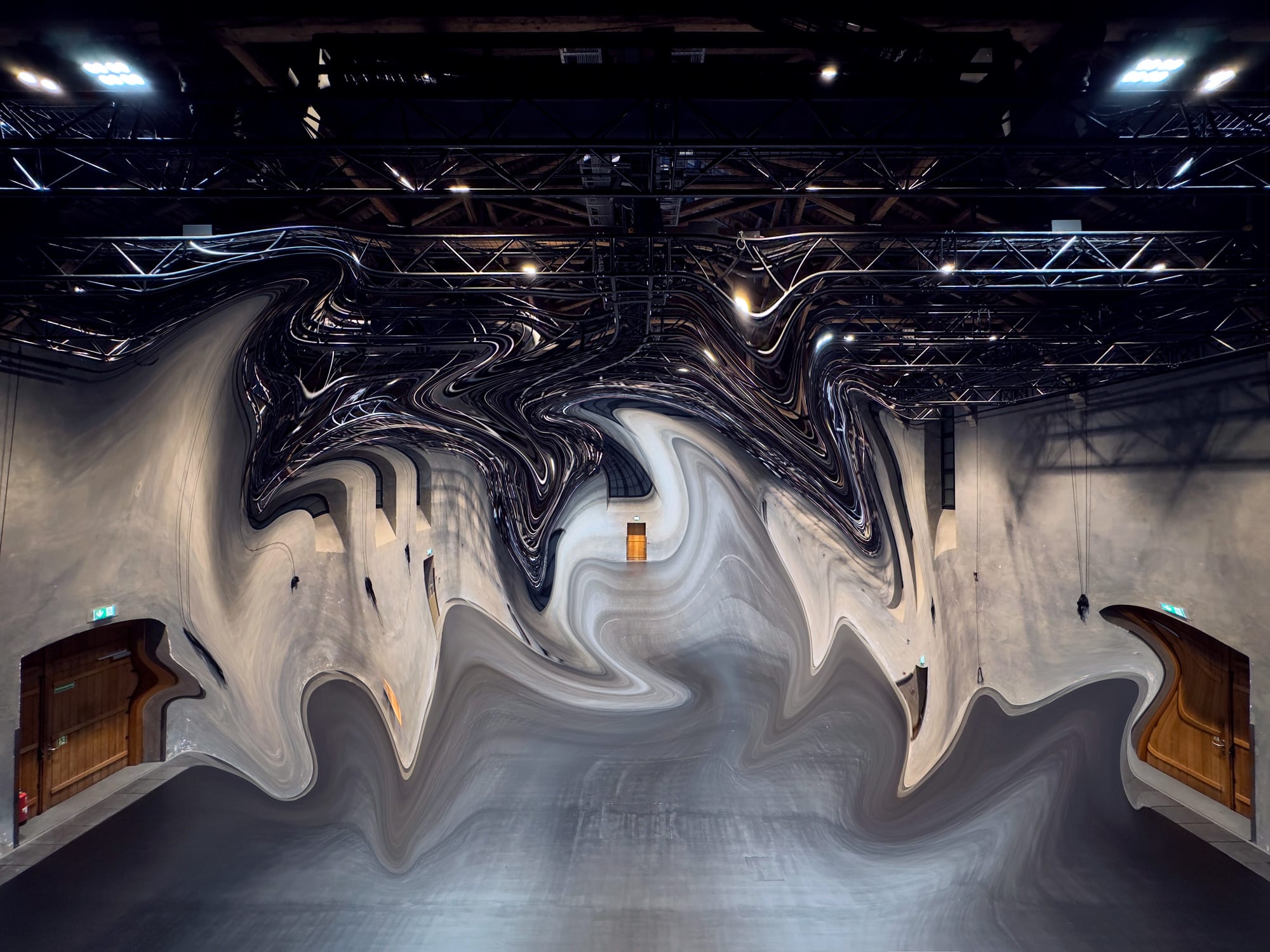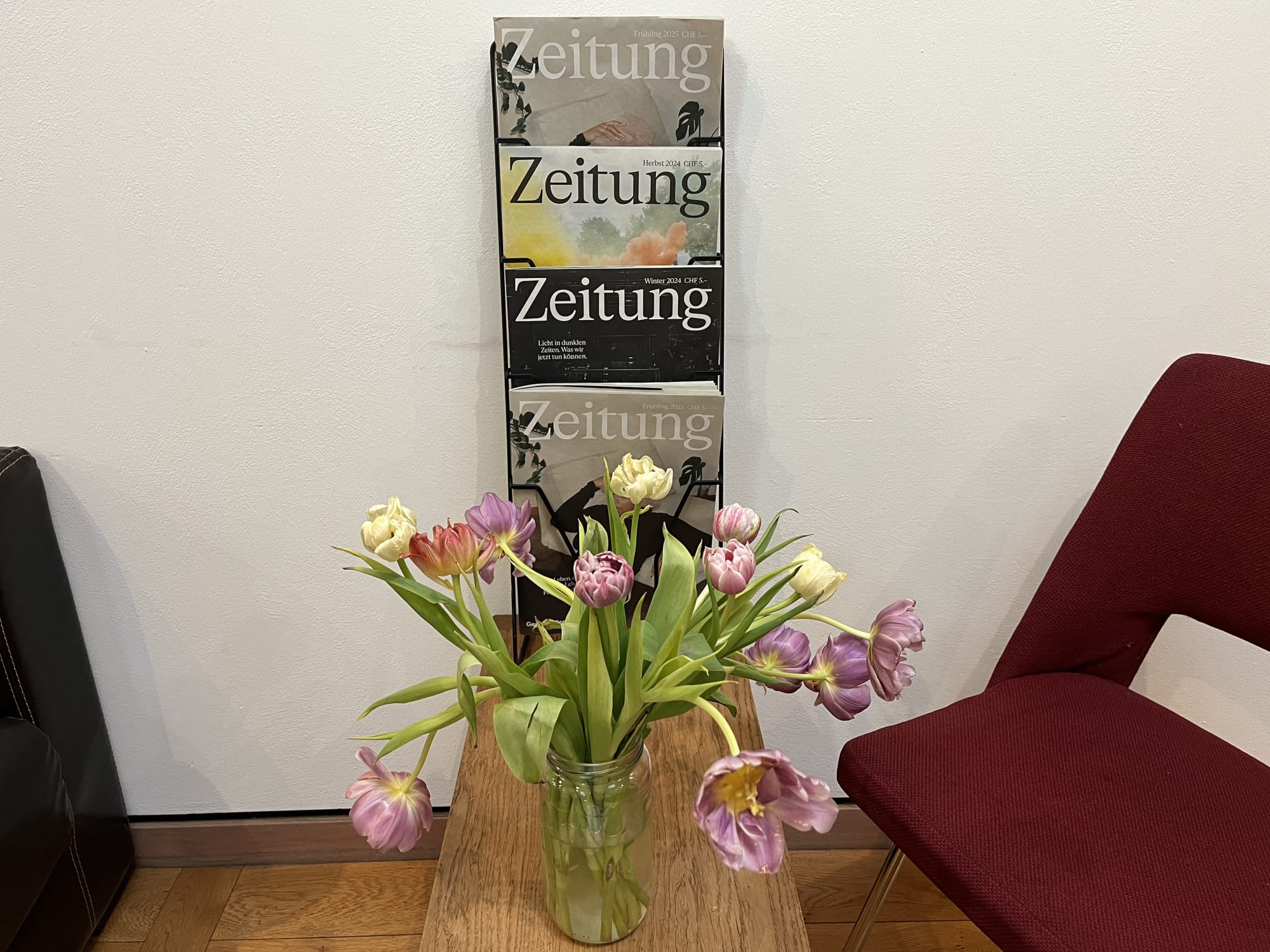Weekly letter
‘All of a sudden worst-case scenarios are lurking everywhere’
In May Ben Burger and Mona De Weerdt are performing the play ‘In Case of Emergency’ at Gessnerallee. We asked the artists three questions about the production. Weekly letter #34
Credits: Extraleben «In Case of Emergency»
Dear visitors to Gessnerallee, dear artists
At the beginning of May the performance ‘In Case of Emergency’ will be staged for the first time in Gessnerallees’ large hall. In this week's newsletter, Ben Burger and Mona De Weerdt provide an insight into the processes of the piece, which highlights the ‘poetic paradox of disaster prevention’ and in which the theatre apparatus virtually performs itself on stage.
Ben Burger, your work often deals with the connection between capitalism and catastrophe. In the project ‘In Case of Emergency’, you and your artistic team look at Gessnerallee as a theatre in the event of a disaster and question the premises of disaster prevention. What inspired you to do this?
Ben Burger: The idea for the project came about in 2020 in a conversation with the technical director of Gessnerallee at the time. We learned that the Gessnerallee is located in the flood plain of the Sihl and that if the Sihldam burst, an eight-metre-high flood wave would hit the building. This surprised and frightened us. I have been living on the Sihl near Manegg for two years now. The Sihl is a supposedly harmless and calm river; we would never have imagined that it would pose such a devastating threat. We also came across a poetic paradox of disaster prevention: Before it can be prevented a disaster has to happen first - in the mind's eye of the person responsible for safety. For an adequate risk assessment, this person must always assume the worst. This is where things suddenly become theatrical in a terribly fascinating way - the catastrophe takes place in this person's mind and raises questions of reality about its potential for danger and escalation. In our present time of polycrises, this takes on an oppressive topicality: the destabilisation of the climate and, of course, the political world situation go hand in hand with a creeping erosion of our sense of security - suddenly worst-case scenarios are lurking everywhere.
Experts consider the risk of a dam bursting on Lake Sihl to be very low, yet the consequences of this have been a recurring topic of discussion in Zurich for years. Why is the danger of such a dam bursting so fascinating here? And what did your research reveal?
Ben Burger and Mona De Weerdt: That's right. The dam failure itself is not a probable event - the dam is literally bomb-proof. But disasters do not arise from a single incident, but are an accumulation of various unfavourable events that gradually break safety-relevant boundaries. We all probably still remember the flood disaster in the Ahr valley in Germany. Excessively high temperatures in the Mediterranean evaporated more water into rain clouds, a slowdown in atmospheric cloud movement due to climate change and a sudden drift in the weather led to the Ahr Valley region being disproportionately affected by heavy rainfall for several days in the summer of 2021. The soil could no longer absorb water, the built-up steep slopes acted like water slides and a flood wave rushed through the valley at an incredible speed. In the end, the crisis management team failed, unable to imagine that the worst-case scenario would actually materialise, despite precise warnings. The whole thing cost many people their lives. The politician in charge had his red Sunday Porsche rescued, but not the 12 people with disabilities in the Lebenshilfehaus who fell victim to the floods unprepared. This shows that vulnerable people such as those with limited mobility, visual or hearing impairments are particularly at risk in the event of a disaster, and that social and economic injustices manifest themselves in an emergency. In short: disasters are not democratic.
You describe the format as a walk-through audiovisual installation. In it, a choreography unfolds along prevailing safety regulations, escape routes, fire safety regulations and potential hazards. The audience experiences the performance through the perspective of disaster prevention. What exactly can the audience expect?
Ben Burger and Mona De Weerdt: ‘We have the great opportunity to perform in the entire double hall of the Gessnerallee. The audience enters the hall and can move around freely. The guests are given headphones and follow a narrative, while at the same time the room transforms more and more. As we are working on the basis of safety regulations, this evening will not be organised by performers, but by the people who usually ensure that everything runs smoothly behind the scenes. The technicians and evening managers carry out open reconstructions in the room, simulate evacuations and imagine a disruption in the theatre. The theatre apparatus performs itself, so to speak, and questions, based on its own safety aspects, how safe we as a society actually still are today and on which (old) premises this safety is built. Extreme weather events and natural disasters are on the increase, the climate is spiralling out of control and we are seeing a political shift to the right worldwide. Security guarantees and certainties are crumbling, democracies are collapsing and a general destabilisation is manifesting itself on many levels. What once seemed safe is no longer so. ‘In Case of Emergency’ is therefore a poetic reflection on the uncertain and contradictory times in which we live.

Credits: Extraleben «In Case of Emergency»
Now for the weekly overview of the programme, newspaper articles, news and everything we want to share with you:
23 April, 5.30 pm
‘Art in Conflict: Transforming Political Imagination Through Sound’ by artasfoundation
Artistic creation in crisis regions is confronted with challenging questions. In this series of monthly talks, different actors come together to reflect on their experiences in the form of a table discussion. This time with Stas Shärifullá / HMOT (artist and researcher in the field of sound and listening practice). More information
8 May, 6 pm
‘Lick Life Against the Direction of Its Fur’ by Tyra Wigg
An invitation to a speculative dialogue: between the ‘online attention economy’, the time directly before it and the biology of our digestive system. Together with the three performers, we embark on a search for collective progress and are confronted with various temporalities, movements and sentences from social media feeds. More information
8, 10, 12, 13 May, 8 pm
‘In Case of Emergency - Anatomoy of a catastrophe’ by Extraleben
When the Sihldamm dam in Einsiedeln bursts, Gessnerallee has to be evacuated. The work simulates an emergency and scrutinises the premises of disaster prevention in a critical and playful way. More information
Newspaper
«Wo, wenn nicht hier, können wir noch?»
The world we know has come apart at the seams. Yuvviki Dioh, diversity agent at the Schauspielhaus, describes the zeitgeist in the column ‘Thoughts on Theatre’ as follows: ‘It is shaping up to be difficult not to fall into a powerlessness that fools us into thinking we are incapable of acting.’
But despite the difficulties, she finds the beginnings of a hopeful and effective place - in the theatre. ‘We try to do it, with the community and the collective, with coming together, with listening and learning, with knowledge, with diversity and anti-discrimination and much more. It's often great. We often fail. But we try.’ You can find the full text in our third print edition and online from today (only in German).
Furthermore
As part of the four-part ‘OPEN STUDIO’ project by Dimitri de Perrot, artists working and living in Zurich can now apply for a residency. For four months the project will focus on hearing and listening in the Südbühne at Gessnerallee Zurich. Selected artists or groups/collectives will be invited to work together with Dimitri de Perrot and his team from Studio DdP for three weeks on sound productions. At the end, the lab will be opened to the public for three days and the work will be presented, discussed and shared. The application deadline is 10 May. All details about the project and the application process
And here's more exciting news for artists: Company glitch is now opening the doors of its centrally located, 200 square metre studio to professional dance companies and artists working with interactive technologies. They offer open rehearsal slots, a dance studio, a work area, an equipped kitchen and shower facilities. Further information and photos of the space
We look forward to your visit.
The Gessnerallee team
PS: Do you enjoy good cultural stories? Or do you know someone who doesn't like going to the theatre so much, but loves reading? Then we recommend a subscription to our printed newspaper, which is published four times a season. It costs CHF 20 (excl. postage) and you can order it directly at zeitung@gessnerallee.ch.

Would you like to stay informed about events at the Gessnerallee? Subscribe to our weekly letter.
More articles
New newspaper edition, winter break and New Year
17 December 2025
From Team Gessnerallee
An edition full of role models. Weekly letter #62 Read


New newspaper edition, winter break and New Year
17 December 2025
From Team Gessnerallee
An edition full of role models. Weekly letter #62 Read
(In)visibility
10 December 2025
From Rahel Bains, Kathrin Veser and Miriam Walther
The sixth edition of our newspaper is here. An edition full of role models. Read

Afterglow is good, anticipation is even better
10 December 2025
From Team Gessnerallee
Why it's far from over in the independent scene after 50, but on the contrary can be really enjoyable. Weekly letter #61 Read